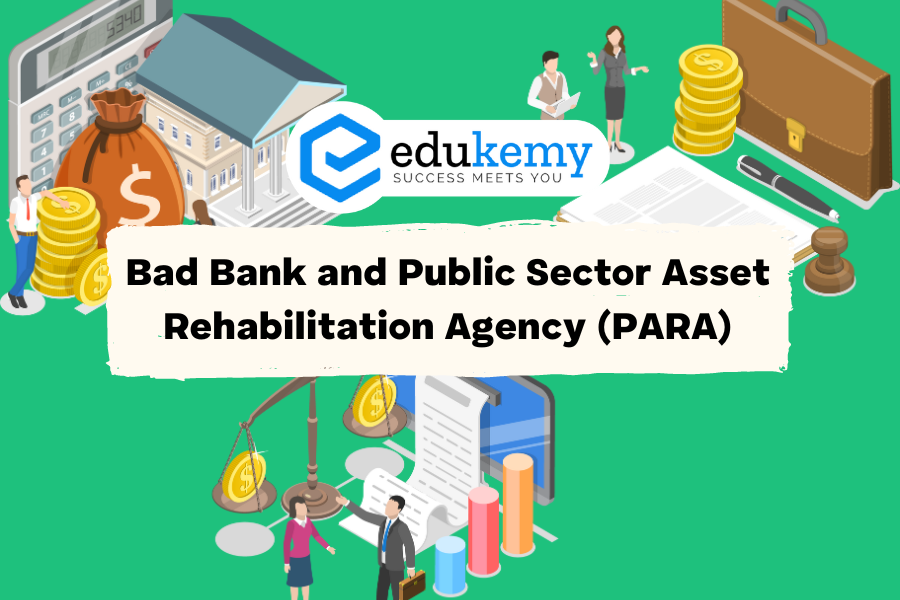
Introduction: The concept of a “bad bank” or a dedicated institution like the Public Sector Asset Rehabilitation Agency (PARA) has been proposed to address the issue of non-performing assets (NPAs) in Public Sector Banks (PSBs). The Economic Survey 2016-2017 recommended the establishment of PARA to act as a special purpose vehicle (SPV) to address the NPA problem.
Key Points:
- Purpose of PARA:
- PARA serves as an SPV with the specific goal of resolving the NPA problem in PSBs.
- The agency is designed to raise funds by issuing government bonds, which will be used to purchase significant bad loans from PSBs.
- Advantages of PARA:
- Relieving PSBs of NPAs: PARA aims to relieve PSBs of the burden of holding significant NPAs.
- Faster Resolution: Consolidating bad loans under PARA allows for a quicker resolution compared to individual bank settlements.
- Better Bargaining Power: Having a single entity like PARA as the buyer provides an advantage in negotiating terms for the purchase of bad loans.
- P.J. Nayak Committee Recommendations:
- The P.J. Nayak Committee, set up by the RBI, provided governance-related recommendations for banks.
- Recommendations included reducing the government’s stake in PSBs to below 50%, professionalizing board appointments, and introducing fixed terms for top management positions.
- Union Budget 2021-22 and Bad Bank:
- The Union Budget 2021-22 announced the establishment of a bad bank to address stressed assets in banks.
- The bad bank would operate through an Asset Reconstruction Company (ARC) model.
- Banks can transfer distressed assets to this entity at a discounted rate, and professionals will work on resolutions, enabling originating banks to focus on new business.
- COVID-19 Impact and Bad Bank:
- The economic challenges posed by COVID-19 exacerbated the NPA problem.
- Establishing a bad bank is seen as a strategy to free up banks from the burden of bad loans, facilitating credit growth.
- Project Sashakt (2018):
- In 2018, the government introduced “Project Sashakt,” a plan for PSBs that included a five-point strategy for bad loan resolution.
- The plan involved setting up an independent Asset Management Company (AMC) aligned with the Insolvency and Bankruptcy Code (IBC) to focus on asset turnaround, job creation, and protection.
The establishment of PARA or a bad bank reflects a strategic approach to efficiently manage and resolve the challenges posed by NPAs in PSBs, aiming for a healthier financial sector and economic growth.
FAQs
Q: What is a Bad Bank?
A: A Bad Bank is a financial institution that specializes in buying up non-performing assets (NPAs) or distressed assets from other banks at a discounted price. Its primary objective is to clean up the balance sheets of banks by transferring these troubled assets, thereby helping them to focus on their core lending activities and improving their financial health.
Q: How does a Bad Bank function?
A: A Bad Bank typically purchases NPAs from other banks or financial institutions at a discounted price, often using funds provided by the government or private investors. It then works on recovering as much value as possible from these assets through various means such as restructuring, asset sales, or debt recovery processes. The profits generated from these activities are used to cover the acquisition costs and operational expenses of the Bad Bank.
Q: What is the purpose of establishing a Public Sector Asset Rehabilitation Agency (PARA)?
A: The establishment of PARA aims to address the issue of rising NPAs in the Indian banking sector, particularly among public sector banks. PARA serves as a specialized entity dedicated to resolving and rehabilitating stressed assets in a systematic and efficient manner. It assists in the resolution of NPAs through mechanisms such as asset restructuring, debt recovery, and asset sales, thereby improving the overall health of the banking system.
Q: How does PARA differ from a traditional Bad Bank?
A: While both PARA and a Bad Bank share the common objective of addressing NPAs, PARA specifically focuses on resolving distressed assets within the public sector banking system. It operates under a government-backed framework and collaborates closely with regulatory authorities and public sector banks to facilitate the resolution process. Additionally, PARA may have access to additional resources and regulatory support compared to a traditional Bad Bank.
Q: What are the potential benefits of implementing a Bad Bank or PARA?
- Asset Quality Improvement: By transferring NPAs to a specialized entity like a Bad Bank or PARA, banks can clean up their balance sheets and focus on productive lending activities, thereby improving their asset quality.
- Financial Stability: Resolving NPAs helps enhance the overall stability of the banking sector by reducing the burden of toxic assets and mitigating systemic risks.
- Credit Flow: With healthier balance sheets, banks are better positioned to extend credit to businesses and individuals, stimulating economic growth.
- Investor Confidence: The establishment of a Bad Bank or PARA signals a proactive approach by the government towards resolving the NPA crisis, potentially boosting investor confidence in the banking sector.
In case you still have your doubts, contact us on 9811333901.
For UPSC Prelims Resources, Click here
For Daily Updates and Study Material:
Join our Telegram Channel – Edukemy for IAS
- 1. Learn through Videos – here
- 2. Be Exam Ready by Practicing Daily MCQs – here
- 3. Daily Newsletter – Get all your Current Affairs Covered – here
- 4. Mains Answer Writing Practice – here

